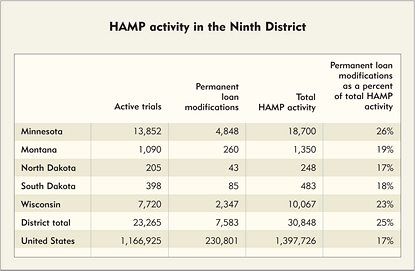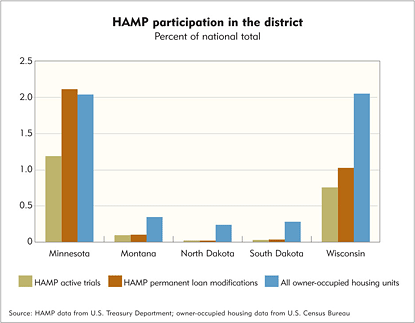
If the Home Affordable Modification Program is a homeowner’s lifeline, it hasn’t let out much rope, particularly in the Ninth District.
HAMP is the much ballyhooed federal program designed to help struggling homeowners stave off foreclosure by making their mortgages more affordable.
The program is open to homeowners with a mortgage originated before Jan. 1, 2009, and who show certain signs of payment stress, such as delinquency or payments that consume a disproportionate amount of a family’s monthly budget. HAMP’s goal is to get distressed homeowners into a mortgage that is more affordable—in this case, defined as 31 percent of household income.
To date, the program has fallen well short of the Treasury Department’s initial goals to permanently help 3 million to 4 million homeowners. Through March, according to a monthly program report, about 230,000 homeowners have had their loans permanently modified, most often by lowering the interest rate paid on the loan or extending its term or both. Another 1.2 million loans are in a trial period, which acts as something of a probation.
Fewer than 7,500 homeowners in the Ninth District (including all of Wisconsin and excluding the Upper Peninsula of Michigan) had their mortgages permanently modified by the end of February, and another 23,000 were in active trial periods (see table). The district’s share of nationwide participation is well below its overall share of owner-occupied homes, with a small exception in Minnesota (see chart). Lower program activity in the district is explained in part by the fact that the housing and economic slumps have not been as intense in district states compared with the nation.
In district states, Minnesota is the biggest HAMP user by a fairly wide margin, even compared with similarly sized Wisconsin (see table). Again, this is likely explained by the fact that Minnesota’s housing sector saw the biggest run-up and subsequent decline of any district state. On the other end, though the Dakotas are small in size to begin with, their participation in HAMP rounds virtually to zero (see chart). District states also had a higher ratio of permanent modifications to total HAMP activity—25 percent versus 17 percent nationwide.
Permanent modifications have a dramatic effect on household budgets, reducing (median) monthly mortgage payments by 36 percent, or more than $500, according a monthly program report in late April. In some cases, borrowers saw their interest rates slashed from 7.5 percent to 2 percent and extended to 40 years. The cost of that reduction is shared by Treasury from leftover emergency funds from the Troubled Asset Relief Program (TARP) and the first lien holder.
Reports by the Government Accountability Office and the special inspector general to TARP have highlighted difficulties implementing HAMP and the slow movement of trial modifications to permanent modifications. These troubles stem from a variety of factors, including difficulty of loan servicers in obtaining required documents, along with borrowers missing payments during the trial period.
The program has also struggled with repeated alterations and additions. For example, in late March, the Treasury Department announced an initiative, slated for startup in the coming months, that encourages principal write-downs to address falling (and often negative) home equity that blocks some homeowners from refinancing and taking advantage of low mortgage rates.
Maybe more alarming, despite good intentions, it’s not clear that the program is helping much and may simply be postponing the inevitable for many households. A late-March report by two bank regulatory agencies at Treasury looked at permanent modifications completed in the first quarter of 2009—the first vintage of modifications under the program, and only a small sliver of total modifications to date. Nonetheless, within nine months of modification to a more affordable mortgage, more than half of these mortgages were at least 60 days past due.
Ron Wirtz is a Minneapolis Fed regional outreach director. Ron tracks current business conditions, with a focus on employment and wages, construction, real estate, consumer spending, and tourism. In this role, he networks with businesses in the Bank’s six-state region and gives frequent speeches on economic conditions. Follow him on Twitter @RonWirtz.







